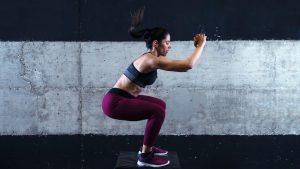How Jump Squats Aid Weight Loss

The Calorie-Burning Effect
Jump squats are a high-intensity exercise that elevates your heart rate rapidly. This intense burst of energy requires more oxygen, causing your body to work harder and burn more calories. The higher the intensity, the more calories you burn during and after the exercise due to the “afterburn effect” or excess post-exercise oxygen consumption (EPOC).
Muscle Engagement
Jump squats primarily target the quadriceps, hamstrings, glutes, and calves. Engaging these large muscle groups not only burns calories during the exercise but also increases your basal metabolic rate (BMR). A higher BMR means your body continues to burn more calories even at rest, aiding in weight loss.
Improved Metabolism
Regularly incorporating jump squats into your workout routine can lead to improved metabolism. As your body adapts and builds lean muscle mass, it becomes more efficient at burning calories, further supporting weight loss efforts.
Tips for Effective Jump Squats
Proper Form: Maintain proper form to prevent injury. Keep your back straight, chest up, and land softly to minimize impact on your joints.
Start Slowly: If you’re new to jump squats, begin with a few repetitions and gradually increase as your strength and endurance improve.
Include Variations: Mix up your routine with different variations like sumo jump squats or plyometric jump squats to challenge your muscles differently.
Combine with Other Exercises: Incorporate jump squats into a full-body workout routine for better results.

So.
Jump squats are a valuable addition to your fitness regimen, aiding in weight loss by burning calories, engaging multiple muscle groups, and boosting metabolism. However, it’s essential to pair exercise with a balanced diet and other forms of physical activity for optimal results.
How to Incorporate Jump Squats Into Your Routine
Warm-up
Before diving into jump squats, ensure your body is adequately warmed up. Perform light cardio or dynamic stretches to prepare your muscles for the workout and reduce the risk of injury.
Interval Training
Incorporate jump squats into a high-intensity interval training (HIIT) routine. Alternate between periods of intense exercise (like jump squats) and rest or lower-intensity activities. This method is highly effective for burning calories and improving cardiovascular fitness.
Circuit Training
Include jump squats in a circuit workout. Combine them with other exercises such as lunges, push-ups, or planks. This keeps your routine varied and engages different muscle groups for a full-body workout.
Frequency and Rest
Start with 2-3 sessions per week, allowing at least a day of rest in between to give your muscles time to recover and grow stronger. As you become more conditioned, you can gradually increase the frequency.
Proper Nutrition
While exercise is crucial for weight loss, a balanced diet is equally important. Fuel your body with nutritious foods, focusing on lean proteins, complex carbohydrates, healthy fats, and plenty of fruits and vegetables.
Final Thoughts
Jump squats can be a fantastic tool in your weight loss journey, but they work best when part of a holistic approach that includes regular exercise, proper nutrition, and adequate rest. Remember to listen to your body, start at your comfort level, and gradually increase intensity as you progress.
By incorporating jump squats into your fitness routine and maintaining a healthy lifestyle, you’ll not only burn calories and lose weight but also improve your overall strength and endurance.
For more guidance on fitness routines and nutrition tips, consider exploring the following resources:
Best Foods to Eat Before and After a Workout by the Academy of Nutrition and Dietetics
5 HIIT Workouts for Beginners by Shape
The Benefits of Adding Plyometric Exercises to Your Workout by Mayo Clinic
7 Jump Squat Variations for a Full-Body Workout by Self
How to Do Jump Squats Correctly by Healthline
Importance of High-Intensity Interval Training (HIIT) for Weight Loss by Verywell Fit
Remember, consistency and variety in your workouts can make a significant difference in achieving your weight loss goals.
Comparison tabular
Here’s a comparison table that breaks down the key aspects of jump squats in relation to weight loss:
| Aspect | Jump Squats | Traditional Squats |
|---|---|---|
| Muscle Engagement | Engages multiple muscle groups simultaneously | Focuses primarily on lower body muscles |
| Calorie Burn | High-intensity exercise, burns more calories quickly | Lower intensity, burns fewer calories per unit of time |
| Cardiovascular Benefit | Elevates heart rate rapidly, good for cardiovascular health | Less impact on heart rate |
| Metabolic Impact | Increases basal metabolic rate due to muscle engagement | Moderate impact on metabolism |
| Variations | Various types (plyometric, sumo, etc.) for muscle diversity | Standard form with limited variations |
| Intensity | High intensity, requires more energy and effort | Moderate intensity, less demanding |
| Overall Effectiveness | Effective for weight loss due to intensity and muscle engagement | Beneficial but might require longer workouts for similar effects |
| Suitability for Beginners | Can be challenging initially, modifications available | Easier to start with and progress gradually |
This table offers a quick comparison between jump squats and traditional squats, highlighting the aspects relevant to weight loss and fitness. Both exercises have their merits, but jump squats tend to provide a more intensive workout, which can lead to greater calorie burn and muscle engagement, hence supporting weight loss efforts more effectively.
Wrapping up
In the pursuit of weight loss and fitness, the choice between jump squats and traditional squats often comes down to your preferences, fitness level, and goals. While both exercises contribute to a healthier lifestyle, jump squats stand out for their high-intensity nature, engaging multiple muscle groups, and quick calorie burn.
If you’re looking to shed pounds and rev up your metabolism, integrating jump squats into your workout routine can be a game-changer. However, don’t overlook the value of traditional squats, especially if you’re starting your fitness journey or prefer a lower-impact exercise.
Ultimately, what matters most is finding an exercise routine that you enjoy and can sustain. Remember, weight loss is a journey that combines exercise, nutrition, and consistency. Whether you’re jumping into high-intensity workouts or sticking to traditional exercises, the key is to keep moving, stay motivated, and make healthy choices along the way. Here’s to your fitness success.

Hey there, it’s Mike Rrsq, the Editor-in-Chief over at Jsquat.com, and I’m absolutely obsessed with all things squat fitness! I’ve been lucky enough to get some serious recognition for my work in this field. With a solid background in the fitness and wellness industry, I’ve been there right from the get-go, helping shape this website into what it is today.
You see, I’m not just the boss around here; I’m also a passionate contributor. I love sharing my insights through my articles, and trust me, they’re not your run-of-the-mill stuff. Each piece I write is a labor of love, filled with my expertise and real-world experience in the fitness universe. So, if you’re into fitness and looking for some inspiration, you’re in the right place!
Related Posts
- Are Squats Without Weight Effective? (Explained)
Are you wondering if squats without weight are worth your time? Learn the benefits and…
- Do Squats Burn Fat or Build Muscles? (things to Know- Explained)
Want to know if squats burn fat or build muscles? This comprehensive guide has…
- Progressing in Weight and Reps: Mastering Back Squats
Back squats are a foundational exercise in any strength training routine, targeting multiple muscle groups…
- Understanding When to Increase Weight in Your Back Squats
The back squat is a foundational exercise in weightlifting, offering a plethora of benefits for…
- If you can do a pistol squat, does that mean you could do barbell squats of your weight
Being able to perform a pistol squat doesn't necessarily translate directly to being able to…
- Why Do Squats Make Me Feel a Burn In My Quadriceps: Explained)
Many often wonder why they feel a burning sensation specifically in their quadriceps when doing…
- No Burn, No Gain: Why Can't I Feel My Squats? (Explained)
Hey there, fellow fitness enthusiast! If you've ever done squats and felt like you're not…
- Unveiling the Power of Squats and Jump Exercises for Activating Your Gluteus Medius
Squats and jump exercises are renowned for sculpting a strong, toned lower body. But do…
